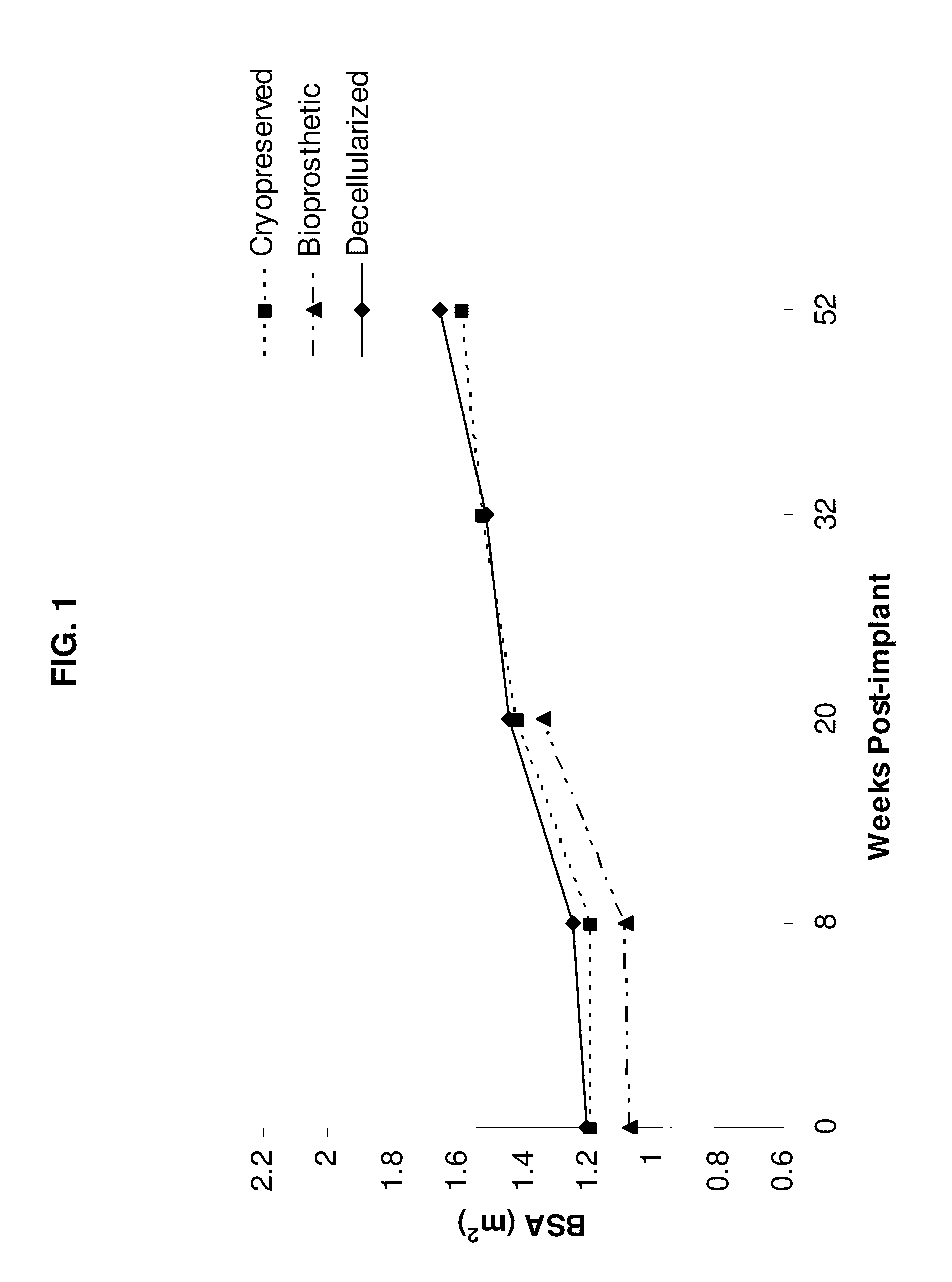Method for decellularization
a tissue engineering and decellularization technology, applied in the field of tissue engineering constructs and tissue engineering methods, can solve the problems of less etoh concentrations that can be used, and achieve the effects of less calcification, reduced inflammation, and improved tensile strength and elastic modulus
- Summary
- Abstract
- Description
- Claims
- Application Information
AI Technical Summary
Benefits of technology
Problems solved by technology
Method used
Image
Examples
example 1
[0070]This example illustrates analysis of the differences between decellularized, cryopreserved, and bioprosthetic heart valves.
Materials and Methods
Animals
[0071]All animal procedures were carried out under protocols approved by the Institutional Animal Care and Use Committee and animals received humane care in compliance with the Guide for Care and Use of Laboratory Animals (NIH Publication #85-23). Nineteen female domestic sheep (ovis ares; Suffolk / North Country Cheviot; 160±9d, 46.5±9 kg) were divided into three treatment groups. Group 1 sheep (n=8) were implanted with cryopreserved homografts further treated with a series of steps resulting in the decellularization of the tissue. Group 2 sheep (n=6) were implanted with cryopreserved homografts and Group 3 sheep (n=4) were implanted with a commercially available glutaraldehyde-preserved porcine aortic root bioprostheses (Freestyle, Medtronic, Minneapolis, Minn.). Sheep were survived for either 20 wk (Group 1, n=4; Group 2, n=3; ...
example 2
[0106]This examples illustrates one embodiment of the decell process of the present invention.
Materials and Methods
Solutions Used:
[0107]a. Triton X®-100 (Triton): 0.05% Triton X®-100 solution a 1:2000 dilution derived from 100% Triton X®-100 detergent (Sigma T8787) in ddH2O. Each valve will need 200 mL of this solution, which can be made ahead of time.[0108]For 2 L use 1 mL 100% Triton-X®, 1999 mL ddH2O.[0109]b. N-lauroylsarcosine Sodium Salt Solution (NLS): 1% NLS Solution a 1:20 dilution derived from 20% Sodium Laureth Sulfate (Sigma—L7414) in ddH2O. Each valve will need 200 mL of this solution, which can be made ahead of time.[0110]For 2 L use 100 mL 20% NLS, 1900 mL ddH2O[0111]c. Hypertonic Salt Solution (HSS): 1% NaCl (Fisher—BP358-1), 12.5% D-Mannitol (Sigma—M9647), 5 mM MgCl2 (Sigma—M2643), 500 mM KCl (Sigma P4504) in NS (Normal Saline). Each valve will need 200 mL of this solution which can be made ahead of time.[0112]For 2 L use 2 L NS, 18 gm NaCl, 2.03 gm MgCl2, 74.3 gm KC...
example 3
[0124]This example illustrates the multi-anionic detergent / enzyme pH controlled reciprocating osmolality mammalian heart valve decellularization method for the creation of ECM Scaffold to be used for heart valve tissue engineering.
Materials and Methods
[0125]Hearts were aseptically harvested during multi organ donor harvest. The transport solution were sterile lactated ringers or PBS solution with 4× amphotericin B*=4 ug / ml and 4× penicillin / streptomycin*=400 IU / mL) were provided in advance. *standard tissue culture medium concentrations were Ampho (250 ug / mL) at 8 ug / mL=2 mL / 500 mL and Pen / Strep (10 K IU / mL) at 100 IU / mL=5 mL / 500 mL.
[0126]The valves were dissected in a laminar flow safety cabinet using sterile technique and stored, individually, in sterile 250 mL bottles with fresh transport solution at 4° C. for a maximum of 72 hours. All solutions and solvents used were sterile. Next a muscle shelf debridement protocol was performed.
[0127]On the first processing day, the valves we...
PUM
| Property | Measurement | Unit |
|---|---|---|
| time | aaaaa | aaaaa |
| time | aaaaa | aaaaa |
| time | aaaaa | aaaaa |
Abstract
Description
Claims
Application Information
 Login to View More
Login to View More - R&D
- Intellectual Property
- Life Sciences
- Materials
- Tech Scout
- Unparalleled Data Quality
- Higher Quality Content
- 60% Fewer Hallucinations
Browse by: Latest US Patents, China's latest patents, Technical Efficacy Thesaurus, Application Domain, Technology Topic, Popular Technical Reports.
© 2025 PatSnap. All rights reserved.Legal|Privacy policy|Modern Slavery Act Transparency Statement|Sitemap|About US| Contact US: help@patsnap.com



